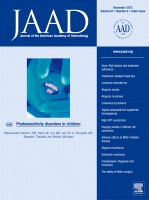
Superficial x-ray in the treatment of basal and squamous cell carcinomas: A viable option in select patients
| Journal: | Journal of the American Academy of Dermatology |
| Issue and Date: | December 2012 Volume 67 Issue 6 |
| Authors: | Armond B Cognetta MD, Brett M Howard BA, Henry P Heaton BA, Earl R Stoddard MD, Hykoyoung Grace Hong PhD, W Harris Green MD |
| Abstract: | Background Effective nonsurgical modalities are limited in the treatment of basal cell carcinoma (BCC) and squamous cell carcinoma (SCC). Objective We sought to evaluate the efficacy and viability of superficial x-ray therapy in the treatment of BCC and SCC in an outpatient setting. Methods A retrospective analysis was performed on 1715 histologically confirmed primary cutaneous BCC and SCC treated with superficial x-ray therapy at Dermatology Associates of Tallahassee in Florida between 2000 and 2010. Results Of the 1715 tumors reviewed during this period, 712 were histologically proven BCC (631 nodular and 81 superficial), 994 were SCC (861 SCC in situ and 133 invasive SCC), and 9 displayed distinct features of both BCC and SCC in the same biopsy specimen. Kaplan-Meier estimates (with 95% confidence intervals) of cumulative recurrence rates of all tumors at 2 and 5 years were 1.9% (1%-2.7%) and 5.0% (3.2%-6.7%), respectively; of BCC at 2 and 5 years were 2% (0.8%-3.3%) and 4.2% (1.9%-6.4%), respectively; and of all SCC at 2 and 5 years were 1.8% (0.8%-2.8%) and 5.8% (2.9%-8.7%), respectively. Tumors on male patients and those with a diameter greater than 2 cm were associated with a statistically significant increase in recurrence likelihood. Limitations This study represents only patients treated in 1 dermatology office in North Florida and may not be representative of the general patient population. Conclusions Superficial x-ray therapy remains a viable nonsurgical option for the treatment of primary BCC and SCC in patients where surgical intervention is declined, unadvisable, or potentially associated with significant cosmetic or functional limitations. |
